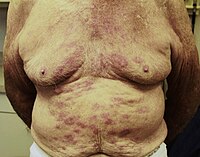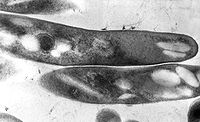
Development of LepReact, a defined skin test for paucibacillary leprosy and low-level M. leprae infection
Sign Up to like & getrecommendations! Published in 2020 at "Applied Microbiology and Biotechnology"
DOI: 10.1007/s00253-020-10505-2
Abstract: The persistence of new leprosy cases in endemic areas such as India, Brazil, Bangladesh, and the Philippines has encouraged studies of chemoprophylaxis among contacts of patients. Epidemiological screening tools to enable early detection of infected… read more here.
Keywords: infection; leprae; test; skin test ... See more keywords

Characterization of ML0314c of Mycobacterium leprae and deciphering its role in the immune response in leprosy patients.
Sign Up to like & getrecommendations! Published in 2018 at "Gene"
DOI: 10.1016/j.gene.2017.12.001
Abstract: Mycobacterium leprae has a reduced genome size due to the reductive evolution over a long period of time. Lipid metabolism plays an important role in the life cycle and pathogenesis of this bacterium. In comparison… read more here.
Keywords: mycobacterium; response; leprosy patients; response leprosy ... See more keywords

Probing the structure-function relationship of Mycobacterium leprae HSP18 under different UV radiations.
Sign Up to like & getrecommendations! Published in 2018 at "International journal of biological macromolecules"
DOI: 10.1016/j.ijbiomac.2018.07.151
Abstract: Ultraviolet radiation, an effective sterilizing source, rapidly kills the causative organism (Mycobacterium leprae) of leprosy. But, the reasons behind this quick death are not clearly understood. Also, the impact of UV radiation on the antigen(s)… read more here.
Keywords: leprae; mycobacterium leprae; structure; function ... See more keywords

Nasal PCR assay for the detection of Mycobacterium leprae pra gene to study subclinical infection in a community.
Sign Up to like & getrecommendations! Published in 2017 at "Microbial pathogenesis"
DOI: 10.1016/j.micpath.2017.01.046
Abstract: Leprosy is a chronic infectious disease caused by Mycobacterium leprae. Identification of Mycobacterium leprae is difficult in part due to the inability of the leprosy bacillus to grow in vitro. A number of diagnostic methods for… read more here.
Keywords: nasal pcr; leprae; mycobacterium leprae; pra gene ... See more keywords

Pathogenicity and virulence of Mycobacterium leprae
Sign Up to like & getrecommendations! Published in 2022 at "Virulence"
DOI: 10.1080/21505594.2022.2141987
Abstract: ABSTRACT Leprosy is caused by Mycobacterium leprae (M. leprae) and M. lepromatosis, an obligate intracellular organism, and over 200,000 new cases occur every year. M. leprae parasitizes histiocytes (skin macrophages) and Schwann cells in the… read more here.
Keywords: virulence mycobacterium; mycobacterium leprae; leprae; pathogenicity virulence ... See more keywords

Phenolic glycolipid‐1 of Mycobacterium leprae is involved in human Schwann cell line ST8814 neurotoxic phenotype
Sign Up to like & getrecommendations! Published in 2022 at "Journal of Neurochemistry"
DOI: 10.1111/jnc.15722
Abstract: Leprosy is a chronic infectious disease caused by Mycobacterium leprae infection in Schwann cells. Axonopathy is considered a hallmark of leprosy neuropathy and is associated with the irreversible motor and sensory loss seen in infected… read more here.
Keywords: cell; phenotype; pgl; schwann cell ... See more keywords

Intracellular Mycobacterium leprae Utilizes Host Glucose as a Carbon Source in Schwann Cells
Sign Up to like & getrecommendations! Published in 2019 at "mBio"
DOI: 10.1128/mbio.02351-19
Abstract: Leprosy remains a major problem in the world today, particularly affecting the poorest and most disadvantaged sections of society in the least developed countries of the world. The long-term aim of research is to develop… read more here.
Keywords: host glucose; schwann; host; cell ... See more keywords

Social and environmental conditions related to Mycobacterium leprae infection in children and adolescents from three leprosy endemic regions of Colombia
Sign Up to like & getrecommendations! Published in 2019 at "BMC Infectious Diseases"
DOI: 10.1186/s12879-019-4120-2
Abstract: BackgroundLeprosy is is still considered a public health issue and in Colombia 7–10% of new cases are found in children, indicating both active transmission and social inequality. We hypothesized that circulating antibodies against Natural Octyl… read more here.
Keywords: social environmental; leprae; mycobacterium leprae; children adolescents ... See more keywords

Reservoirs and transmission routes of leprosy; A systematic review
Sign Up to like & getrecommendations! Published in 2020 at "PLoS Neglected Tropical Diseases"
DOI: 10.1371/journal.pntd.0008276
Abstract: Leprosy is a chronic infectious disease caused by Mycobacterium leprae (M. leprae) and the more recently discovered Mycobacterium lepromatosis (M. lepromatosis). The two leprosy bacilli cause similar pathologic conditions. They primarily target the skin and… read more here.
Keywords: transmission; systematic review; disease; leprae ... See more keywords

A phylogenomic study quantifies competing mechanisms for pseudogenization in prokaryotes—The Mycobacterium leprae case
Sign Up to like & getrecommendations! Published in 2018 at "PLoS ONE"
DOI: 10.1371/journal.pone.0204322
Abstract: Background Pseudogenes are non-functional sequences in the genome with homologous sequences that are functional (i.e. genes). They are abundant in eukaryotes where they have been extensively investigated, while in prokaryotes they are significantly scarcer and… read more here.
Keywords: pseudogenization; phylogenomic study; leprae; study quantifies ... See more keywords

Mycobacterium leprae promotes triacylglycerol de novo synthesis through induction of GPAT3 expression in human premonocytic THP-1 cells
Sign Up to like & getrecommendations! Published in 2021 at "PLoS ONE"
DOI: 10.1371/journal.pone.0249184
Abstract: Mycobacterium leprae (M. leprae) is the etiological agent of leprosy, and the skin lesions of lepromatous leprosy are filled with numerous foamy or xanthomatous histiocytes that are parasitized by M. leprae. Lipids are an important… read more here.
Keywords: leprae; expression; mycobacterium leprae; tag ... See more keywords